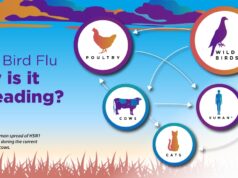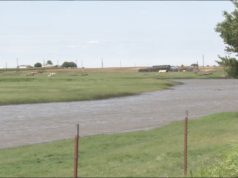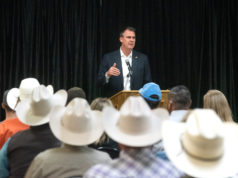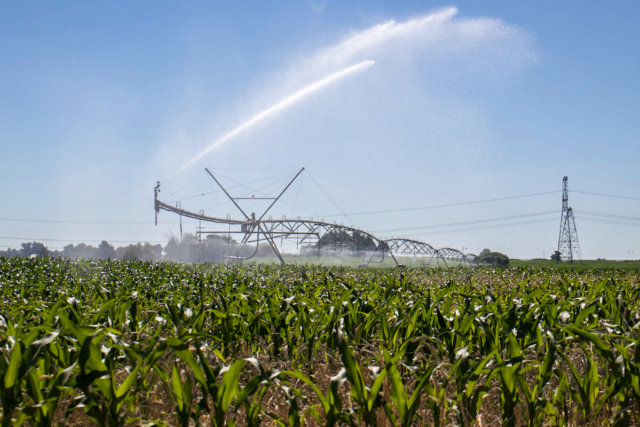

By Jackie Wang, Nicole Tyau and Chelsea Rae Ybanez with contribution from Andrea Jaramillo
News21
CASCO, Wis. – Lynda Cochart did not realize her water was contaminated with coliform bacteria until she contracted MRSA, an antibiotic-resistant skin infection. She believed it came from the water in her well in Casco, Wisconsin. “There’s no other way I could have gotten it,” she said.
A year later, U.S. Department of Agriculture microbiologist Mark Borchardt tested her well while testing others in Kewaunee County. He found total coliform bacteria at levels too dangerous to drink. Cochart lives between two dairy farms with over 1,000 cows each. None of the bacteria Borchardt found came from human feces, she said, so the methicillin-resistant Staphylococcus aureus most likely came from cow manure. Borchardt told her to immediately stop drinking the water.
“He said, ‘What I found in your well is what I expect to find in a Third World country,’” Cochart recalled. When she told him she still needed to shower with that water, Borchardt advised, “Then keep your eyes closed and your mouth shut.”
In California’s San Joaquin Valley, which grows nearly one-quarter of the nation’s food, fertilizer and manure spread on farms’ fields and orchards have contributed to unsafe nitrate levels in drinking water sources. The News21 analysis of Environmental Protection Agency records of community water systems shows 491 instances of unsafe nitrate amounts in many of the region’s 663 community water systems over the past 10 years.
Many farmworkers who live in these communities still have to pay for the contaminated water coming from the faucet, as well as buying bottled water to drink. But the farmers who employ them don’t agree with their concerns.
“They say, ‘Why are you complaining? You have jobs? We are giving you jobs. You eat because of us,’ ” said Irma Medellin, who works with Latino farmworkers in Tulare County to clean up the drinking water. “They contaminate our water, and we, the poor, are paying for water as if we were rich. And we are not rich. But we are paying the price of contaminated water.”
The News21 analysis shows that the drinking water of millions of Americans living in or near farming communities across the country is contaminated by dangerous amounts of nitrates and coliform bacteria from fertilizer and manure widely used in agriculture. Community water systems serving over 2 million people across the country were cited for excessive nitrate levels.
While the 5,050 nitrate violations can largely be traced back to agricultural activity, the 22,971 total coliform violations could be from either human or animal feces. However, in heavily farmed areas, much of the coliform bacteria can be attributed to manure.
Those records don’t cover the millions of private wells that many Americans use, which are left vulnerable to pollution of shallow groundwater in agricultural areas.
A 2012 University of California, Davis, study attributed high nitrate levels in the San Joaquin Valley groundwater to crop and animal agriculture activities based on an analysis of land use and the amount of nitrogen entering the water. Farmers’ heavy use of fertilizers and manure on their crops account for most of the nitrate found in the studied area.
An Iowa Geological Survey researcher found in 2004 that row crops, such as corn, cotton and soybeans, contributed the most to high nitrate levels in Iowa’s rivers. In 2007, U.S. Geological Survey researchers found that Iowa was one of nine Midwestern farming states that contributed over 75 percent of the nitrates that flow from the Mississippi River into the Gulf of Mexico. And a 2010 study by researchers from the University of Illinois and Cornell University found that the biggest contributors of excessive nitrate to the Mississippi River were in the Midwestern corn belt.
People living farther away from agricultural areas also are vulnerable to farming pollution because contaminants can flow downstream in rivers and groundwater.
In Wisconsin, the USDA’s Borchardt tracked manure runoff from a field to the tap water of a nearby home after the water ran brown. Three days later, genetic testing showed the same bacteria traveled 1,500 feet through groundwater to another home’s well.
In 2016, the Columbus Division of Water issued a nitrate contamination warning not to drink the city’s water after heavy rain pushed fertilizer into a watershed 60 miles north of the Ohio city, the second nitrate advisory in two years.
“They’re increasing,” said Kristy Meyer, who oversees the Ohio Environmental Council’s water programs as the managing director of natural resources. “Now you’re starting to see drinking water utilities spend a lot more money to be able to treat the water and keep their customers safe.”
For example, Des Moines, Iowa, is surrounded by farms that grow the most corn, soybeans, eggs and hogs in the nation. Fertilizer and stored manure drain into the groundwater and flow into streams and rivers, leaving people to pay to treat their drinking water.
The Des Moines Water Works, which serves half a million people in Iowa’s capital, draws most of its water from the Raccoon River and Des Moines River. The utility shelled out over $2 million from 2013 to 2015 to reduce nitrates to safe drinking standards, and will soon have to spend up to $183.5 million to build a new treatment facility.
Des Moines Water Works sued three northern Iowa counties in 2015, accusing the 10 drainage districts in those counties of dumping nitrates into the Raccoon River without a federal permit. The river runs for 186 miles from Buena Vista County to the Des Moines River, south of downtown Des Moines. The drainage districts use “tile drainage,” which moves groundwater directly under the soil through underground pipes and into the river, turning saturated land into farmable land.
The Iowa Supreme Court dismissed the case earlier this year because state law protects drainage districts from lawsuits. Though the drainage districts were not penalized, studies point to agricultural runoff as a major contributor of nitrates in the Raccoon River.
Farming contaminated water poses health risks
Two of the most prominent farming contaminants in water are nitrates and total coliform bacteria.
Nitrate-related contamination comes from fertilizer for crops and manure. The body digests nitrates and turns it into nitrites, which inhibits red blood cells’ ability to carry oxygen. The EPA limits nitrate levels to prevent infants from contracting blue baby syndrome, a potentially fatal disorder that deprives infants of oxygen. Research indicates that long-term exposure may affect adults as well.
For the past 20 years, National Cancer Institute researcher Mary Ward has been researching drinking water contaminants, focusing on nitrates and cancer risk. She followed a group of people in Iowa to do so. Though studies need to be repeated before drawing conclusions, she said her research suggests drinking water with high levels of nitrates increases the risk for gastrointestinal and urinary tract cancers.
Tom Nolan, a hydrologist with the USGS, said in agriculturally intense areas, it’s fair to say the majority of nitrate pollution comes from agricultural sources.
“That’s just because that’s where the sources are,” Nolan said. “In agricultural areas, there are higher applications of fertilizer … You can look at (nitrate) exceedance rates and they’re highest in shallow groundwater in agricultural areas.”
Fertilizer and manure not only increase nitrates in drinking water sources, but also fuel algae blooms that make water unsafe to drink and harder to treat. Cyanobacteria grows in phosphorous-heavy waters, which is primarily caused by manure and fertilizer runoff. Also known as blue-green algae, cyanobacteria becomes problematic for drinking water systems in treatment facilities. During the sanitation process, water treatment facilities apply chemicals to kill the cyanobacteria. When the cell dies, it releases cyanotoxins, which can have health effects ranging from fever to pneumonia to death, according to the EPA.
“The blue-green algae is not regulated. There’s no EPA requirement to test for it,” said Bill Stowe, the CEO and general manager of Des Moines Water Works. “We test for it because we know from our experience that it is an adverse risk that is unregulated now, but smaller communities don’t have the resources or knowledge to do that.”
Beyond the problems cyanotoxins create, the chemicals that kill the algae react with organic material in the water and create disinfection byproducts (DBPs), which increase cancer risk. The News21 analysis showed that water systems across the U.S. were cited over 28,000 times in the last decade for exceeding the DBP legal limit, exposing over 25 million people to unsafe levels of DBPs.
Cyanotoxins and cyanobacteria “are significant risks for us because we increase our use of chlorine,” Stowe said. “When you increase one, you increase the likelihood of creating carcinogens.”
The other major source of water contamination from farming is total coliform bacteria from raw, untreated manure. When rain falls on recently fertilized fields, it pushes contaminants from the surface deeper into the soil, and eventually into groundwater. People can see and smell the brown water from their taps. But in the days before or after, water can continue to be contaminated even if the water runs clear.
Drinking water with total coliform bacteria can cause gastrointestinal illnesses, which are linked to diarrhea, stomach cramps, nausea and fever.
The California Division of Drinking Water is supplying 20 communities in the agricultural San Joaquin Valley with bottled water because of nitrate or coliform bacteria pollution. According to the News21 analysis, the most nitrate citations in the United States over the past 10 years were recorded in Tulare County, which is in the valley. Though nitrates and bacteria are currently below the legal limit, the department still delivers water to them because of historic issues with contamination.
Each resident of unincorporated community Tooleville in Tulare County receives half a gallon of water for drinking and cooking per day, delivered every month and paid for by the state. For many residents, it isn’t enough.
One Tooleville resident, Esther Ceballos, buys extra cases of water for herself, her two children and her husband. She still pays $40 a month for tap water she does not use for drinking or cooking.
Rosa Rubio, who lives next to Ceballos, relies on the bottled water delivery for herself, her husband and their four dogs. She said they’ve known their water was undrinkable since they first moved in, thanks to a neighbor who warned them. Sometimes, their tap water comes out white.
“Even if they say it’s OK, we’re scared to use that water,” she said.
Environmental regulation of agriculture is mostly voluntary
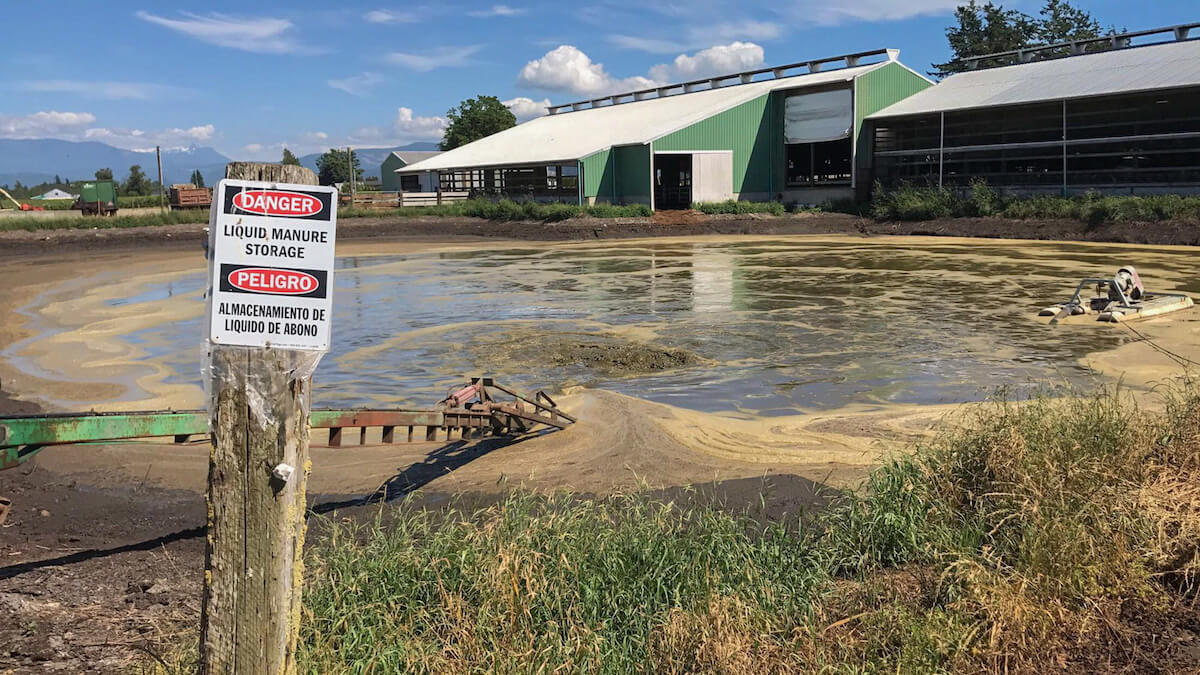
On a still day in the northwest corner of Washington state, a brown, swirling pool burps methane as liquid manure shoots from a pipe propped up by a tractor. But when a breeze comes by, the smell of 1.5 million gallons of liquid cow manure hits the nose and then lingers in the back of the throat for hours.
This is the manure lagoon on Terry Lenssen’s 710-cow dairy farm. Lenssen has only fallen into his manure lagoon once, accidentally backing a tractor into the pit. He’s steered clear of the lagoon ever since. “I smelled like shit for three days,” he laughed. “Must get into your pores or something.
Thousands of dairy farmers around the United States store their cows’ manure like Lenssen does, in separate forms: liquid into a large pit, and the solids heaped into soft, dry mountains. Hog and chicken farmers also store vast amounts of manure to use later as fertilizer.
Dairy farmers usually take the liquid manure and apply it to their fields where they grow corn and alfalfa to feed their cattle. But when a farmer applies too much manure for plants to absorb, the rest finds its way out. In addition to that, lagoons can spill over or spring a leak. In a 2013 report about the Lower Yakima Valley in Washington state, the EPA estimated one dairy’s lagoon leaked between 482,000 to 5.9 million gallons of liquid manure per year into the surrounding soil.
The EPA started regulating what goes into federal waterways in the 1972 Clean Water Act amendments. Many industries must apply for National Pollutant Discharge Elimination System permits, which allow certain discharges into national waterways. But farming is exempt from the Clean Water Act, unless the EPA designates a farm as a concentrated animal feeding operation (CAFO).
And many CAFOs have not applied for discharge permits. Although the number of CAFOs increased by 956 between 2011 and 2016 to a total of 19,496 in the United States, the number of discharge permits held by CAFOs has gone down 1,806 in the same five-year period.
Lenssen has not registered as a CAFO yet. Washington state implemented a new CAFO permit in March, but both environmental groups and dairy organizations immediately filed appeals against the new regulations. In the meantime, Lenssen has a 2-inch-thick binder holding his voluntary nutrient management plan as a testament to his environmental responsibility.
Nutrient management plans are intended to hold farmers accountable for what they apply and how much of it. States decide if they require these plans and how detailed they need to be. While some states, such as Maryland, require farmers to work with a certified professional to construct a nutrient management plan, others don’t require consultation with an engineer or nutrient management expert, and farmers can submit their own plans for approval.
“Frankly, if I was to go and open a business today, I would need a business plan but also a permit of some kind,” said Meyer, of the Ohio Environmental Council. “Why shouldn’t one of the largest industries in the United States be required to have a permit?”
The Natural Resources Conservation Service, an arm of the Department of Agriculture, works with farmers to craft nutrient management plans on a voluntary basis. Each region of the U.S. has different priorities in its plans. Groundwater varies by geographic location. Conditions in one region of a state may drastically differ from a neighboring region of the same state. Aquifers are underground sections of rock that water moves through, and the type and amount of rock, soil and gravel it contains vary by region. Porous rock, such as karst, allows surface water to move quickly into the aquifer below, making it more vulnerable to contamination.
Farmers and beneficiaries shape agriculture policy
If an aquifer is contaminated, the private wells that draw water from it become contaminated too. Yakima County in Washington state, home to around 67 dairy farms, sits on aquifers the EPA determined to be contaminated by nitrates.
Larry Fendell, a 60-year-old ex-farmer, regularly attends Lower Yakima Valley Groundwater Management Area (GWMA) meetings. Its board first met in 2012 to solve nitrate contamination problems in the Lower Yakima Valley groundwater, but Fendell has been fighting for stricter regulations of large dairy farms for 20 years.
“And even if there are regulations, so many things are suggestions,” Fendell said. “Nutrient management plans are suggestions. There’s no teeth behind them. Everything is voluntary.”
Dairyman Dan DeGroot represents the Yakima Dairy Foundation at GWMA meetings. He’s part of the advisory committee steering the research and planning to reduce nitrate concentration in groundwater. DeGroot said he defends himself from people who accuse dairy farms of being the biggest polluter of groundwater.
“I said, ‘You know what, I care more about drinking water than any of you people in here,’” DeGroot said. “It’s of critical importance because I’ve got 3,500 animals, plus 35 people, plus seven in my family – all drinking this water. I care. A lot.”
Though Yakima County is 49 percent Hispanic, the 22-person groundwater management board is all white, save for one Latino representing the Washington State Department of Health. It has not had an active Latino community representative since April. This leaves an already vulnerable community out of the discussion to remedy high nitrate levels, which significantly affect lower-income Latino farmworkers who rely on private wells.
For over three decades, the American Farm Bureau Federation has pushed to exempt farming from environmental regulation. For example, fertilizer and manure are not regulated by the Clean Water Act because agricultural activities are considered “nonpoint source pollution,” which means it comes from many sources.
In 2015, a federal judge ruled that over-applied manure could be regulated as waste after examining a case brought against a Washington dairy. The Washington State Dairy Federation, dairy organizations and farm publications opposed the ruling, but also cautioned dairy farms to exceed manure management expectations and prove that more environmental regulation was unnecessary.
U.S. Rep. Dan Newhouse, a well-to-do farmer and Republican congressman who represents farming-focused counties in Washington state, even filed a bill that would exempt fertilizer and animal manure from being regulated as solid waste entirely. Out of the $747,916 Newhouse received from political action committees between 2015 to 2016, 29 percent came from agriculture and food-related PACs.
The American Farm Bureau alone spent almost $3.8 million in lobbying nationally in the 2016 election cycle, according to the Center for Responsive Politics. The center also reported agribusiness organizations – which include farming, food production and stores – spent $127.5 million last year in lobbying the federal government.
Local farming lobbyist Steve George joined a tour of a Washington dairy farm by dairymen Jason Sheehan and DeGroot for News21. George is secretary of the Yakima County Farm Bureau, has been active as a spokesman for the Washington State Dairy Federation and works as a dairy nutrition consultant.
Keeping his arms crossed and his sunglasses on a furrowed brow, George occasionally interjected his thoughts into the conversation while following the dairy tour group closely, always making sure no one was alone with the reporters. Like other dairy operators News21 spoke with, George pointed to leaky septic systems as an underrepresented contributor of nitrate to drinking water sources, compared with farming.
Yet according to the federal conservation service, manure from a dairy milking 200 cows produces as much nitrogen as is in the sewage from a community of 5,000 to 10,000 people.
George and DeGroot criticized the terms “corporate” and “factory farming,” arguing the words are only used as fuel for environmental activists to attack farms.
“What is factory farming?” DeGroot asked. “To me, I always considered that to be kind of a good thing, comparing me to a factory that is very organized, very smooth, efficient. That’s what it feels like to me.”










